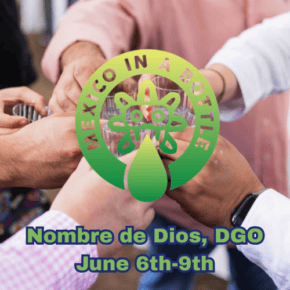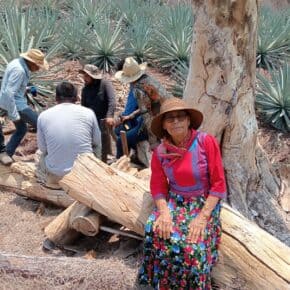Every time I come to Puebla I learn something new about the mezcal industry, history, and traditions. Here are 10 things to know to open up our collective understanding of agave spirits in Puebla. As we delve in, let’s remember to be mindful of the environmental and social impacts of mezcal tourism, especially when considering or planning a trip.
- There Is A Lot Of It
We may only have a handful of mezcals from Puebla available internationally, but there are actually a ton of Poblano brands. This is distinct from brands that have an offering from Puebla, perhaps alongside offerings from other states. With increasing local support and interest, there are regular expositions featuring these brands, raising awareness about artesanal Poblano brands, and promoting their very own Ruta De Mezcal.
- Women Are At The Forefront
Women have always been involved in all aspects of mezcal, from the agricultural aspects to the processing and distilling, bottling, and selling- we know this from listening to the elders within mezcal cultures. Women being recognized for their involvement, and importantly, feeling comfortable being recognized for their involvement, sometimes alongside or instead of the men in their families, is a newer phenomenon, for various complex social reasons. Many of the brands I got to know in Puebla proudly feature maestras mezcaleras and/or women brand owners. We love to see it.
- Plays Well With Oaxaca
Puebla borders the northeastern part of Oaxaca, and ignoring arbitrary political borders (as I am wont to do), they share critical regions with rich biodiversity of agaves and untold history when it comes to mezcal. This shows up in our contemporary traditions as brands that often offer mezcal from both states, as well as brands that use agaves from both states. SomePoblano brands are incorporating mezcal made from agaves grown and harvested in Oaxaca.
- It’s Not New
Yes Puebla was a late addition to the officially recognized Denomination of Origin (DO). Without getting side tracked into the complex discussion of the pros and cons of the DO, let’s just understand that the DO does not determine a region’s history with traditional agave spirits. Based on oral history, anecdotes, and common sense, this region that borders Oaxaca has been producing mezcal for longer than we have documented. Some producers in Puebla will claim that they produced mezcal before Oaxaca, which could make sense if we think of the tradition of distilling agave spirits moving south. But, let’s just agree that Puebla has been making mezcal for a long, long time.
- Multiple & Distinct Regions
Similar to Oaxaca, there are certain towns that are known as mezcalero towns, where there are multiple producers, often with generations of heritage. The regions are distinct and stretched out across the state, some less than two hours away from the city center, and others that are near the border of Oaxaca. As we continue to learn and have more spirits available to taste, stay tuned for an in depth look at the different mezcal producing regions and what they are known for.
- Wide Variety of Agaves
There are a few main varieties that we see at the forefront of mezcal in Puebla. Thanks to the proximity to and shared cultural lands with Oaxaca, it is common to see varieties we typically associate with Oaxaca in Poblano mezcal, like rhodacantha and convallis. In addition to using Oaxacan grown specimens, Puebla has been very proactive in cultivating a wide range of varieties. While much of the production uses wild agaves today, most producers I talked to have cultivated agaves that are 10ish years old, pointing to a growing variety of agaves, similar to Oaxaca, being offered in the near future.
- Regional Pechugas & Infusions
Infusions and pechugas are common and feature regional flavors. The most common pechuga is mole poblano- the mole has an impressive ability to enhance and complement the earthy, sweet, and robust flavors of a quality artesanal mezcal. Another infusion I saw that is very typical of the region is Nogada, the dairy and nut based creamy sauce that adorns the stuffed Chiles en Nogada that Puebla is famous for in August and September. Herbal infusions, including cannabis, are also fairly common.
- Producer Owned Brands
Producer owned brands, and brands owned by relatives of the producer, seem to be common, which is an encouraging sign. Of course there are already big conglomerate brands sticking their hands into the industry, but the majority of the brands I came across were small, artisanal, and with a personal connection to the producer, if not straight up producer owned.
- It’s Coming To A Store/Bar Near You
Many of the brands are in the final stages of getting ready to export. One big reason we don’t see more Poblano mezcal in the international market yet is because they were a later addition to the official DO. The process to certify and jump through all of the bureaucratic hoops to be ready for export takes time and money. They know that the public is thirsty for these spirits, and importers and distributors are actively looking for more Poblano brands to bring on board. Stay tuned as the influx of Poblano mezcal is imminent.
- Widely Available Regionally
Can’t wait for your local bar or store to stock more Poblano mezcal? You can easily find many quality bottles for sales in Puebla. Most restaurants with a liquor license have at least a small offering of local mezcal, and many have an extensive offering. You don’t need to visit the production sites (though plenty of producers offer paid tours) to find more bottles than can comfortably fit in your suitcase. Just a 2 hour ride from Mexico City, with bus lines that connect directly to/from Mexico City International Airport- it’s an easy trip for even the mildly adventurous. Check out my list of where to drink mezcal in Puebla.













Leave a Comment